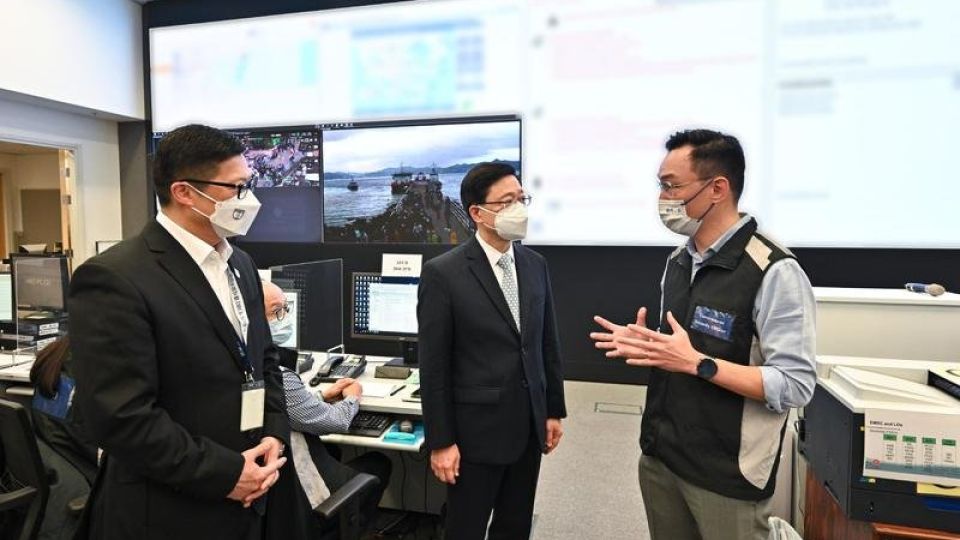January 13, 2023
HONG KONG – The Hong Kong Special Administrative Region government on Thursday held a large-scale interdepartmental exercise based on the Daya Bay Contingency Plan (DBCP) to test and enhance the nuclear emergency preparedness of government personnel and their knowledge of dealing with nuclear power station emergencies.
Chief Executive John Lee Ka-chiu, Chief Secretary for Administration Eric Chan Kwok-ki, Secretary for Security Chris Tang Ping-keung, a number of principal officials and about 1,400 personnel from various departments and organizations joined the exercise, codenamed Checkerboard III, according to a government statement.
The starting scenario of the exercise simulated a chain of equipment fault events at the Guangdong Daya Bay Nuclear Power Station (GNPS), leading to a potential off-site emergency situation involving a release of radioactive materials.
Tang said that the safety standards at the GNPS are very high and its performance in terms of safety remains excellent. He said the chance of serious accidents and nuclear emergencies is “very slim”.
Tang said the drill was conducted to ensure the government’s nuclear emergency preparedness and enhance the public’s understanding of nuclear power and nuclear emergency readiness.
The Fireboat 7 that participated in the exercise is the world’s first certified civil CBRN (chemical, biological, radiation and nuclear) defense ship, and is capable of carrying out decontamination procedures onboard for evacuees and monitor outdoor radiation level with its gamma ray detectors
The DBCP is a nuclear emergency response plan in Hong Kong. In addition to internal drills conducted by relevant departments from time to time, the government of the special administrative region has been holding large-scale interdepartmental exercises every three to five years and the previous one was held in 2017.
After the drill began on Thursday morning, the government simulated the activation of the DBCP and the Emergency Monitoring and Support Centre under the Security Bureau as well as the dissemination of emergency information to the public.
Lee, accompanied by Tang, inspected the operation of the EMSC in coordinating with relevant bureaus and departments to handle the nuclear emergency.
To test the government’s capability of adopting appropriate precautionary measures, the police assisted in evacuating villagers and visitors in Tung Ping Chau and the Government Flying Service (GFS) deployed a helicopter to convey police reinforcements to sweep the island.
This photo shows a mobile decontamination unit with shower facility being used by the Fire Services Department to carry out decontamination procedures at Ma Liu Shui Ferry Pier during the Checkerboard III nuclear emergency preparedness exercise on Jan 12, 2023. (PHOTO / HKSAR GOVERNMENT)During the exercise, a police launch swiftly transported the evacuees to Ma Liu Shui Ferry Pier. The Fireboat 7 that participated in the exercise is the world’s first certified civil CBRN (chemical, biological, radiation and nuclear) defense ship, and is capable of carrying out decontamination procedures onboard for evacuees and monitor outdoor radiation level with its gamma ray detectors.
The evacuees were immediately recorded by the Electronic-Casualties Management Solution being developed by the police and received radiation assessment after landing to ensure that they were not contaminated. Mobile decontamination units with shower facilities were also used by the Fire Services Department to demonstrate decontamination procedures for persons with possible contamination.
To enhance the professionalism of the exercise and strengthen exchanges, the SB invited ministries and commissions in the Chinese mainland and experts from overseas, Macao SAR and local organisations to observe the exercise and offer advice to the government.
They included the National Nuclear Safety Administration, National Nuclear Emergency Response Office, China General Nuclear Power Corporation Limited, Nuclear Emergency Committee Office of the Guangdong Province, Nuclear Emergency Committee Office of Shenzhen Municipality, Macao Unitary Police Service and the International Atomic Energy Agency.

Photo shows evacuees boarding a police launch on Tung Ping Chau during the Checkerboard III nuclear emergency preparedness exercise on Jan 12, 2023. (PHOTO / HKSAR GOVERNMENT)
Locally, the Radiological Protection Advisory Group, Guangdong Nuclear Power Stations Nuclear Safety Consultative Committee, Hong Kong Institution of Engineers (Nuclear Division), Hong Kong Nuclear Society and Hong Kong Radiation Protection Society as well as members of the Legislative Council Panel on Security were invited.


